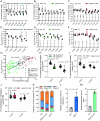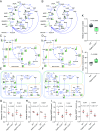Genetic improvement of phosphate-limited photosynthesis for high yield in rice
- PMID: 39136985
- PMCID: PMC11348269
- DOI: 10.1073/pnas.2404199121
Genetic improvement of phosphate-limited photosynthesis for high yield in rice
Abstract
Low phosphate (Pi) availability decreases photosynthesis, with phosphate limitation of photosynthesis occurring particularly during grain filling of cereal crops; however, effective genetic solutions remain to be established. We previously discovered that rice phosphate transporter OsPHO1;2 controls seed (sink) development through Pi reallocation during grain filling. Here, we find that OsPHO1;2 regulates Pi homeostasis and thus photosynthesis in leaves (source). Loss-of-function of OsPHO1;2 decreased Pi levels in leaves, leading to decreased photosynthetic electron transport activity, CO2 assimilation rate, and early occurrence of phosphate-limited photosynthesis. Interestingly, ectopic expression of OsPHO1;2 greatly increased Pi availability, and thereby, increased photosynthetic rate in leaves during grain filling, contributing to increased yield. This was supported by the effect of foliar Pi application. Moreover, analysis of core rice germplasm resources revealed that higher OsPHO1;2 expression was associated with enhanced photosynthesis and yield potential compared to those with lower expression. These findings reveal that phosphate-limitation of photosynthesis can be relieved via a genetic approach, and the OsPHO1;2 gene can be employed to reinforce crop breeding strategies for achieving higher photosynthetic efficiency.
Keywords: grain yield; phosphate transporter; photosynthesis; rice; source and sink.
Conflict of interest statement
Competing interests statement:The authors declare no competing interest.
Figures







References
-
- Heuer S., et al. , Improving phosphorus use efficiency: A complex trait with emerging opportunities. Plant J. 90, 868–885 (2017). - PubMed
-
- Gamuyao R., et al. , The protein kinase Pstol1 from traditional rice confers tolerance of phosphorus deficiency. Nature 488, 535–539 (2012). - PubMed
-
- Veneklaas E. J., et al. , Opportunities for improving phosphorus-use efficiency in crop plants. New Phytol. 195, 306–320 (2012). - PubMed
MeSH terms
Substances
Grants and funding
LinkOut - more resources
Full Text Sources
Research Materials
Miscellaneous

